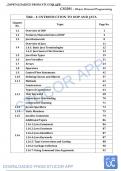Class notes
Java for beginners
- Course
- Institution
**Discover the Ultimate Guide to Mastering Java Programming: Java for Beginners** Are you ready to embark on an exciting journey into the world of programming? Look no further! Our comprehensive "Java for Beginners" PDF is your perfect companion to unlock the powerful and versatile language of J...
[Show more]



